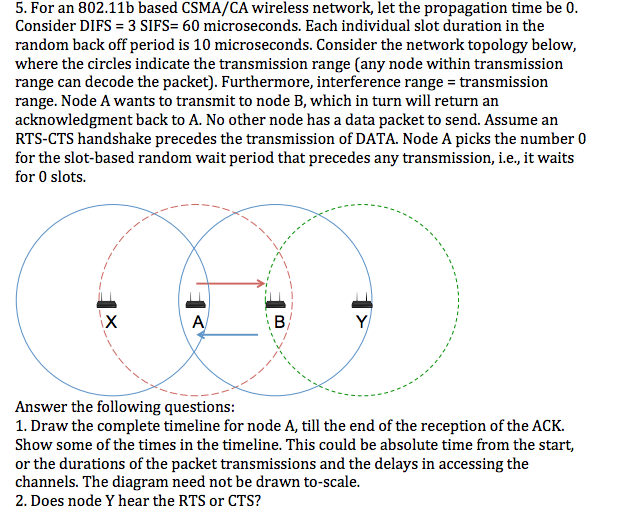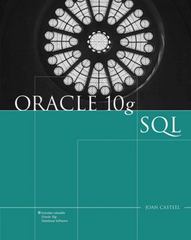For an 802.11b based CSMA/CA wireless network, let the propagation time be 0. Consider DIFS = 3 SIFS= 60 microseconds. Each individual slot duration in the random back off period is 10 microseconds. Consider the network topology below, where the circles indicate the transmission range (any node within transmission range can decode the packet). Furthermore, interference range = transmission range. Node A wants to transmit to node B, which in turn will return an acknowledgment back to A. No other node has a data packet to send. Assume an RTS-CTS handshake precedes the transmission of DATA. Node A picks the number 0 for the slot-based random wait period that precedes any transmission, i.e., it waits for 0 slots.
5. For an 802.11b based CSMA/CA wireless network, let the propagation time be 0 Consider DIFS = 3 SIFS= 60 microseconds. Each individual slot duration in the random back off period is 10 microseconds. Consider the network topology below, where the circles indicate the transmission range (any node within transmission range can decode the packet). Furthermore, interference range = transmission range. Node A wants to transmit to node B, which in turn will return an acknowledgment back to A. No other node has a data packet to send. Assume an RTS-CTS handshake precedes the transmission of DATA. Node A picks the number 0 for the slot-based random wait period that precedes any transmission, i.e., it waits for 0 slots. Answer the following question:s 1. Draw the complete timeline for node A, till the end of the reception of the ACK. Show some of the times in the timeline. This could be absolute time from the start, or the durations of the packet transmissions and the delays in accessing the channels. The diagram need not be drawn to-scale 2. Does node Y hear the RTS or CTS? 5. For an 802.11b based CSMA/CA wireless network, let the propagation time be 0 Consider DIFS = 3 SIFS= 60 microseconds. Each individual slot duration in the random back off period is 10 microseconds. Consider the network topology below, where the circles indicate the transmission range (any node within transmission range can decode the packet). Furthermore, interference range = transmission range. Node A wants to transmit to node B, which in turn will return an acknowledgment back to A. No other node has a data packet to send. Assume an RTS-CTS handshake precedes the transmission of DATA. Node A picks the number 0 for the slot-based random wait period that precedes any transmission, i.e., it waits for 0 slots. Answer the following question:s 1. Draw the complete timeline for node A, till the end of the reception of the ACK. Show some of the times in the timeline. This could be absolute time from the start, or the durations of the packet transmissions and the delays in accessing the channels. The diagram need not be drawn to-scale 2. Does node Y hear the RTS or CTS







